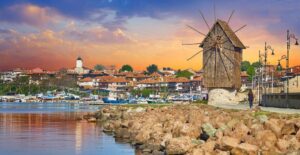San Juan Chamula is a small town in the Mexican state of Chiapas, located at an altitude of around 2,200 meters. The area is known for its beautiful forest landscapes and hiking opportunities. It lies just 10 kilometers from the colonial city of San Cristobal de las Casas, close to the Guatemalan border. The town is named after John the Baptist (Spanish San Juan Bautista), the patron saint of the Chamula people. The residents are primarily from the Tzotzil tribe and speak the Tzotzil language, part of the Mayan language family. They are considered one of the most significant tribes due to their population size and rich cultural heritage.

Chamula is renowned not only for its stunning mountain scenery but also for its charming old church in the heart of the town. From the outside, it appears to be a typical church, but the interior is unlike anything you might expect.

The first thing you’ll notice is the absence of pews and an altar. In fact, this is not a typical Catholic church; everything inside looks quite unusual. The unique blend of Catholicism brought by the Spaniards and the existing Mayan religious customs has created the distinctive religion practiced by the people of Chamula today. This is why visitors are often puzzled by what they see inside the church.
One notable feature is the large wooden statues of saints and mirrors, which the Chamula people believe deflect evil spirits. The local beliefs have merged with Catholicism, so while the images of saints resemble Catholic icons, they actually symbolize Mayan gods.
Photography is prohibited inside the church. Large signs at the entrance warn visitors that cameras are not allowed, as taking photos is considered blasphemous. (I took the liberty of borrowing someone else’s photo. See below.)

Music is always present in the church, with Christmas songs being especially popular year-round. It is said that Christmas decorations and motifs can be found in local homes regardless of the season.
One thing that struck me was the men’s clothing. They were all dressed similarly—in jeans or pants, white shirts, and white woolen ponchos. And, of course, they wore white cowboy hats, as seen in the photos. Dressed this way, they entered the church and performed their rituals. What amazed me was a group of men in the church hanging a huge cross on the wall. They were all dressed the same, focused on their work, and smoking cigarettes without any concern for being in a sacred space.
The air is filled with the scent of incense, and the floor is covered with pine needles, which remind you of Christmas. The locals perform their rituals on this green carpet. What does the ritual involve?
People come to the church, some alone, others with their families. They all find a spot on the pine-covered floor and start their rituals with loud prayers. They place candles directly on the floor in rows, one after another. The prayers continue, powerful enough to touch the soul of anyone present. Each person carries their own pain and comes to the church seeking comfort. The family whose ritual I witnessed was praying for the health of their young daughter. They performed this ceremony for her because she was ill, and the locals believe it will help heal any believer.

They all come prepared, with bags full of items that we, as foreigners, watched with curiosity. Out came soft drinks and alcohol, necessary for the ritual. One of the well-known drinks, famous throughout Chiapas, is called Posh (Spanish El Posh or El Pox). It is a strong alcoholic beverage, similar to our brandy. Everyone in the church carried a bottle of it and poured it into small cups, from which family members drank. Along with Posh, they also poured Coca-Cola into another small cup. Coca-Cola is the most popular and consumed soft drink in the town and is evidently widely used for religious purposes, as all the locals brought and drank it during the ritual. It is even said that the wealthiest person in the village is the Coca-Cola distributor.
From the moving bags, we could occasionally see a chicken head poking out. Chickens play a central role in this ceremony. Locals bring them alive into the church, carefully packed in their bags. Towards the end of the ritual, one of the women takes out as many chickens as she has brought (some bring two, for example), grabs one by the neck, and rubs it over the sick child’s body. The whole family continues to sing and pray aloud until the woman suddenly twists the neck of the chicken and kills it. Why do they do this? They believe that in this way, the negative energy from the sick person transfers to the chicken, along with the illness. This is an important and sacred moment in the ritual. Having killed the animal, they believe the disease has left.
In conclusion, the church in Chamula blends Catholicism with indigenous Mayan customs in its rituals. Despite their unconventional nature to outsiders, these practices hold deep significance for the local community, providing solace and maintaining cultural identity.







